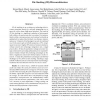802 search results - page 29 / 161 » A comparative study of power efficient SRAM designs |
BMCBI
2008
13 years 7 months ago
2008
Background: The conservation of gene order among prokaryotic genomes can provide valuable insight into gene function, protein interactions, or events by which genomes have evolved...
CODES
2005
IEEE
13 years 9 months ago
2005
IEEE
Caches may consume half of a microprocessor’s total power and cache misses incur accessing off-chip memory, which is both time consuming and energy costly. Therefore, minimizing...
MICRO
2006
IEEE
14 years 1 months ago
2006
IEEE
3D die stacking is an exciting new technology that increases transistor density by vertically integrating two or more die with a dense, high-speed interface. The result of 3D die ...
DAC
2003
ACM
14 years 8 months ago
2003
ACM
Sleep transistors are effective to reduce dynamic and leakage power. The cluster-based design was proposed to reduce the sleep transistor area by clustering gates to minimize the ...
ICCAD
2004
IEEE
14 years 4 months ago
2004
IEEE
Power is an increasingly important design constraint for FPGAs in nanometer technologies. Because interconnect power is dominant in FPGAs, we design Vdd-programmable interconnect ...

